President of Peru
This article needs additional citations for verification. (November 2018) |
| President of the Republic of Peru | |
|---|---|
| Presidente de la República del Perú | |
 Presidential Standard | |
since March 23, 2018 | |
| Style | His Excellency |
| Residence | Palacio de Gobierno |
| Seat | Palacio de Gobierno |
| Appointer | Direct popular election |
| Term length | Five years Not eligible for re-election immediately |
| Inaugural holder | José de San Martín (de facto) José de la Riva Agüero (first to bear the title) |
| Formation | February 28, 1823 |
| Succession | Vice President |
| Deputy | Vice President of Peru |
| Website | www.presidencia.gob.pe |
 |
|---|
|
|
The President of Peru (Spanish: Presidente del Perú), officially called the President of the Republic of Peru (Spanish: Presidente de la República del Perú), is the head of state and head of government of Peru and represents the republic in official international matters. The president personifies the Republic of Peru, is the head of executive power, and is the supreme head of the Armed Forces and Police of Peru. His position corresponds to the highest magistracy in the country and to the highest ranking public official. Presidents de facto who assumed power through political coups are also included in this list.
The presidency of Peru can be held for a period of 5 years without immediate re-election. After a constitutional period, the president is allowed to be re-elected. A presidential inauguration is held every five years on July 28, in the Congress of Peru. The last directly elected President of Peru was Pedro Pablo Kuczynski, from July 28, 2016 to March 21, 2018, when he resigned from office. Following the traditional constitutional succession, First Vice President Martín Vizcarra, former governor of Moquegua, Minister of Transportation, and Ambassador to Canada, succeeded him in office as the 67th President of Peru, on 23 March 2018.
It corresponds, as a generic mandate, to direct the general policy of the government and the administration of the State. Although its role, title and significance have undergone changes throughout history, as well as its position and relations with the other actors of the national political organization, it has been and is the most outstanding political figure. The Political Constitution of Peru in force (1993) establishes the requirements, rights and obligations that the President of the Republic must fulfill.
The president exercises his functions from the House of Pizarro, located in the historic center of Lima, which is the Government Palace of Peru and the House of Government of Lima -mention with which official documents are dated-. This palace, occupies the same location that corresponded to the conqueror and governor, Francisco Pizarro and where later the palace of the viceroys of Peru was located.
There have been a number of presidents that have reached the presidency through a coup d'état. The last successful coup d'état was carried out by Alberto Fujimori in 1992, who is now imprisoned for human rights violations and corruption.
Presidential term and transitions
Ordinarily, presidents are elected for five-year terms, with no opportunity for immediate reelection. A former president can run again after being out of office for a full term.[1] The change of government takes place on July 28, which is the date of independence from Spain and thus a national holiday.
The current Peruvian Constitution of 1993 establishes in its article 113 that the Presidency of the Republic is vacated by:
- Death of the President of the Republic.
- His permanent moral or physical disability, declared by Congress.
- Acceptance of his resignation by Congress.
- Leaving the national territory without permission of the Congress or not returning to it within the established period.
- Dismissal, after having been sanctioned for any of the infractions mentioned in Article 117 of the Constitution.
Four presidents of Peru have resigned: Guillermo Billinghurst (forced resignation), Andrés Avelino Cáceres, Alberto Fujimori, and Pedro Pablo Kuczynski.
Origin
Pre-Columbian Era
The first State recognizable as such under current concepts in the central Andes was the Wari civilization, whose system of government has not yet been fully unraveled. Later, between the thirteenth century and the sixteenth century, the Inca civilization developed, whose State, based on the political management of reciprocity and alien to all European conceptions of then and now, had the Sapa Inca at its head.
The modern Peruvian State is the heir of the Viceroyalty of Peru. In 1532, the Spanish conquerors arrived in the territory, imposed their dominion and managed to establish a Spanish dependency. This dependence began as governorships corresponding to the conquerors, with the title of Governor. The Government of the New Toledo (Diego de Almagro) - which otherwise never consolidated - had as its capital the city of Cusco, the current historical capital of Peru. The Government of the New Castile (Francisco Pizarro) had as its capital the City of Kings, as Lima was also called initially and it was on this that the Viceroyalty was instituted after the civil wars.
In 1542, the Viceroyalty of Peru was established, whose government was held by the representative of the King of Spain (Head of State) with the title of Viceroy of Peru (Head of Government). The true organizer of the viceregal state was Francisco de Toledo.
This period had only two stages corresponding to the two Spanish dynasties: the houses of Habsburg and Bourbon, and lasted 282 years from its establishment in 1542 to the Capitulation of Ayacucho in 1824, despite the independence of Peru in 1821.
Viceroy José Fernando de Abascal was in charge of centralizing Spanish political and military power in Peru. His successors, the last viceroys of Peru were parallel to San Martin and his first successors. Joaquín de la Pezuela and José de la Serna faced the liberating armies and the last of them signed the capitulation. Finally, Pío Tristán was the interim viceroy in charge of transferring power to the patriots.
Republic Era
In July 1821, during the Peruvian War of Independence, the autonomous states lying in the viceroyalty of Peru declared themselves as independent and sovereign from influence and mediation from the Spanish Empire. Recognizing the impending threat of Spanish backlash to regain their lost colonies, the autonomous viceroyalty began to draft a constitution to base the sovereign nation on. Working closely with the Constituent Congress of Peru in 1822, a formal constitution was created, named the Constitution of 1823. Francisco Xavier de Luna Pizarro, a Peruvian politician, presided and led the Constituent Congress of Peru, leading to him being subjectively regarded to as the first informal President of Peru.[2]
The first articles of the 1823 Constitution consisted of 24 items, known as the "Bases". These bases formally defined the borders of the Andean nation and formally created the First Republic of Peru, which still holds until present day. The governing board, led by Luna Pizarro, declared Peruvian autonomy from Spain and a Catholic state. Additionally, the Constitution defined the three powers of the government, the executive, judicial and the legislative power. The Governing Board, a colloquial terminology that was used to classify the ten politicians that devised these 24 items, was the first representation of executive power and the executive branch in Peruvian history.
Later, issues arose around the bases which granted the protectorate of Peru, Simon Bolivar, overwhelming power over the legislative and executive organs of the Peruvian government.[3] At the same time, Bolivar was already undergoing a campaign to establish a dictatorship around Andean Latin American nations. As a precursor, this incentivized the initial drafters of the constitution and the Governing Board to accelerate the process of defining reasonable executive powers, balance the three branches of power, and begin to draft an idea for the roles and powers of the official position of state leader of Peru.
The Act of Independence was signed in Lima on August 15, 1821 and soon after the government was left under the charge of José de San Martín with the title of Protector. Later, the legislative branch occupied the executive branch. In 1823 the Congress appointed José de la Riva Agüero as the first President of the Republic of the history of Peru. Since then, that has been the main denomination that has held the great majority of the rulers of Peru. The same first Political Constitution of 1823 (after the appointment of Riva Agüero) recognizes the position and says ex officio "Article 72. Resides exclusively the exercise of executive power in a citizen with the name of President of the Republic."
Only two constitutions have been contrary, partially, to the presidential republican system, the Lifetime Political Constitution of 1826 emanating from Simón Bolívar and expressing:
The exercise of the Executive Power resides in a Life President, a Vice President, and four Secretaries of State.
By 1827, an outline of an executive along with the executive branch had been drawn out to prevent a Bolivarian dictatorship which would be seen by the populace as a general return to Spanish tyrannical rule.[4] As a result, on July 28, 1827, Manuel Salazar assumed the formal office of the presidency and became the first president of Peru to be elected by the populace, marking the start of the Presidency of Peru.
Powers and duties
1823 Constitution
The President is head of the general administration of the Republic, and his authority extends both to the preservation of public order internally, and to external security in accordance with the Constitution and laws.
The duties exclusive to the President have been defined the 1823 Constitution as:
- To promulgate, execute, protect, and comply with the laws, decrees, and resolutions of the Congress of Peru and to issue the orders indispensable for its effect.
- To have supreme command over the armed forces of Peru.
- To order and verify democratic free elections on the days indicated by the Constitution.
- To declare war when appropriate after being passed through the Congress of Peru.
- To regulate and join peace treaties, alliances, and other agreements coming from foreign states according to the Constitution.
- To oversee and determine the investment of the funds allocated by the Congress of Peru to the various branches of the public administration.
- Appoint officers and officials of the Peruvian Armed Forces with the agreement and consent of Congress.
- Appoint Ministers, members of the Presidential Cabinet, the Prime Minister, and diplomats with the agreement and consent of Congress.
- Ensure the proper administration of justice in the Peruvian Judicial System and on the compliance of the judgments that they pronounce, as well as establish the trial by jury courts.
- Inform the legislature of the political and military status quo of the Republic of Peru, indicating substantial improvements or suitable reforms in every branch of Peruvian society.
Limitations of the Executive Power
- The President cannot and will not personally command the armed force without the consent of Congress.
- The President cannot and will not leave the nation without permission from Congress.
- Under no pretext can the President cannot conduct business with members of the Supreme Court.
- The President cannot and will not deprive any Peruvian of personal liberty, and if public security requires the arrest or detention of any person, the President may order the appropriate detention with the indispensable condition that within twenty-four hours the detainee will be available to their respective judge.
- Furthermore, the President cannot and will not impose any penalties. The Minister who signed the order of detention, and the official who executes it can act un behalf of the detainee's individual freedom.
- The President cannot and will not defer or suspend sessions of the Congress under any circumstances.
1826 "Life" Constitution
The powers of the President of the Republic are:
- Open sessions of the Congress, and present the legislative body a message about the State of the Republic yearly.
- Propose the Vice President of Peru to Congress and appoint Secretaries of the Republic.
- Dismiss the Vice President and Secretaries of the Republic, whenever the President deems it appropriate.
- Send, publish, circulate, and enforce the laws.
- Authorize the regulations and orders that maximizes compliance with the Constitution, laws and public treaties of the Republic.
- Send and enforce the judgments of the Courts of Justice.
- Request the extension of ordinary sessions of the Legislative Body for up to thirty days.
- Convene the Legislative Body for extraordinary sessions, in a case where it is absolutely necessary.
- To have the permanent force of the sea and land for exterior defense of the Republic.
- To send in person the armies of the Republic in peace and in war. When the President is absent from the capital, the Vice President in charge of the Republic will take the duties and responsibilities of the President.
- When the President leads the war in person, the President may reside in all the territory occupied by national arms.
- Have the National Militia for internal security, within the limits of its departments and outside of them, with the consent of the Legislative Body.
- Name all employees of the Army and Navy.
- Establish military schools, and nautical schools.
- Command to establish military hospitals and homes for the disabled.
- Give withdrawals and licenses. Grant the pensions of the military and their families in accordance with the laws, and arrange, according to them, all the rest consequent to this branch.
- Declare war on behalf of the Republic, after the decree of the Legislative Body.
- Grant patents for privateering.
- Take care of the collection and investment of contributions according to the laws.
- Name employees.
- Direct diplomatic negotiations, and celebrate treaties of peace, friendship, federation, alliance, truces, armed neutrality, trade, and any other, always having to precede the approval of the Legislative Body.
- Appoint the Public Ministers, Consuls and subordinates of the Department of Foreign Affairs.
- Receive foreign ministers
- Grant the pass, or suspend the conciliar decisions, pontifical, brief and resigned with the consent of the Power to whom it corresponds.
- Propose to the Chamber of Censors, in short, individuals for the Supreme Court of Justice, and those who have to submit to the Archbishoprics, Bishoprics, Canongias and perks.
- Present to the Senate for approval one of the list of candidates proposed by the Electoral Body for Prefects, Governors and Corregidores.
- Choose one of the list of candidates proposed by the Ecclesiastical Government for priests and vicars of the provinces.
- Suspend up to three months for employees, provided there is cause for it.
- Commute the capital sentences decreed to the inmates by the Courts.
- Issue, on behalf of the Republic, titles or appointments to all employees.
Limitations of Executive Power
- The President may not deprive any Peruvian of his liberty, nor impose on him any penalty.
- When the security of the Republic requires the arrest of one or more citizens, it may not exceed forty-eight hours without placing the accused at the disposal of the competent Court or Judge.
- He may not deprive any individual of his property, but in the event that the public interest so requires, but he must precede a just compensation to the owner.
- It will not be able to prevent the elections or the other functions that by the laws compete to the Powers of the Republic.
- He can not absent himself from the territory of the Republic, nor from the capital, without permission from the Legislative Body.
1860 Constitution
The powers of the President of the Republic are:
- To preserve the internal order and the external security of the Republic without contravening the laws.
- Convene the ordinary Congress and the extraordinary, when there is a need.
- Concurring to the opening of the Congress, presenting a message about the state of the Republic and about the improvements and reforms it deems appropriate.
- Take part in the formation of laws, in accordance with this constitution.
- Enact and enforce the laws and other resolutions of the Congress; and give decrees, orders, regulations and instructions for their better compliance.
- Give the necessary orders for the collection and investment of public revenues in accordance with the law.
- Require judges and courts for the prompt and accurate administration of justice.
- Enforce the judgments of the courts and courts.
- Organize the forces of sea and land: distribute them, and dispose of them for the service of the Republic.
- Have the National Guard in their respective provinces, without being able to remove them, but in case of sedition on the border, or in the war outside.
- To direct diplomatic negotiations and to conclude treaties, placing on them the express condition that they will be submitted to the Congress.
- Receive foreign Ministers and admit the Consuls.
- Appoint and remove the Ministers of State and the Diplomatic Agents.
- To clear licenses and pensions, according to the laws.
- Exercise the Board in accordance with the laws and current practice.
- Present to Archbishops and Bishops, with the approval of Congress, those who are elected according to the law.
- Present for the Dignities and Canongias of the Cathedrals, for the parishes and other ecclesiastical benefits, in accordance with the laws and current practice.
- Celebrate concordats with the Apostolic Chair, following the instructions given by Congress.
- Grant or deny the passage to the conciliar decrees, papal bulls, briefs and rescripts, with the consent of the Congress, and previously hearing the Supreme Court of Justice, if they were related to contentious matters.
- Provide vacant jobs, whose appointment corresponds according to the Constitution and special laws.
1993 Constitution
The President of the Republic, in addition to the Head of State, is the Head of the national Government. Its functions are explicit in the Constitution and the Organic Law of the Executive Power.
- Comply and enforce the Constitution and treaties, laws and other legal provisions.
- Represent the State, inside and outside the Republic.
- Direct the general policy of the Government.
- Ensure the internal order and the external security of the Republic.
- Convene elections for President of the Republic and for representatives to Congress, as well as for mayors and aldermen and other officials indicated by law.
- Summon the Congress to an extraordinary legislature; and sign, in that case, the decree of convocation.
- Direct messages to the Congress at any time and obligatorily, in personal form and in writing, upon the installation of the first annual ordinary legislature. The annual messages contain a detailed exposition of the situation of the Republic and the improvements and reforms that the President deems necessary and convenient for consideration by the Congress. The messages of the President of the Republic, except for the first one, are approved by the Council of Ministers.
- Exercise the power to regulate the laws without transgressing or denaturing them; and, within such limits, issue decrees and resolutions.
- Comply and enforce the judgments and resolutions of the jurisdictional bodies.
- Fulfill and enforce the resolutions of the National Elections Jury.
- Direct foreign policy and international relations; and celebrate and ratify treaties.
- Appoint ambassadors and plenipotentiary ministers, with the approval of the Council of Ministers, with the responsibility of reporting to the Congress.
- Receive foreign diplomatic agents, and authorize the consuls to exercise their functions.
- Preside over the National Defense System; and organize, distribute and arrange the employment of the Armed Forces and the National Police.
- Adopt the necessary measures for the defense of the Republic, the integrity of the territory and the sovereignty of the State.
- Declare war and sign peace, with authorization from Congress.
- Manage public finances
- Negotiate loans
- Dictate extraordinary measures, by emergency decrees with force of law, in economic and financial matters, when the national interest requires it and with a charge of reporting to the Congress. Congress may modify or repeal the aforementioned emergency decrees.
- Regulate tariff rates.
- Grant pardons and commute sentences. Exercising the right of grace for the benefit of the accused in cases where the stage of instruction has exceeded twice its term plus its extension.
- Confer decorations on behalf of the Nation.
- Authorize Peruvians to serve in a foreign army.
- Grant extradition, with the approval of the Council of Ministers, following a report from the Supreme Court of Justice of the Republic.
- Preside over the Forum of the National Agreement, being able to delegate this function to the President of the Council of Ministers.
- Exercise the other functions of government and administration that the Constitution and the laws entrust to it.
The acts of the President of the Republic that lack ministerial endorsement are null. It corresponds to the President of the Republic to preside over the Council of Ministers when it is convened or when he attends its sessions. The President of the Republic appoints and removes the President of the Council. Appoints and removes the other ministers, on proposal and with agreement, respectively, from the President of the Council.
The ministers are individually responsible for their own acts and for the presidential acts they endorse. All ministers are jointly and severally liable for criminal acts or violations of the Constitution or the laws that the President of the Republic incurs or that are agreed upon in the Council, even if they save their vote, unless they resign immediately.
The Constitution of 1993, a product of the Presidency of Alberto Fujimori (1990-2000), is the constitution that is currently in place.
Presidential symbols
Presidential sash
The presidential band is the most distinctive feature that the President wears and has been used since the beginning of the Republic. It was inherited from the last Viceroys. The placement and delivery of the presidential sash symbolize a democratic transition of power. The band is used by the President of Congress until the new president is sworn in.
It is a bicolor band that carries the national colors (red and white). This band is worn diagonally from the right shoulder to the left side of the waist. At the waist, like a brooch, the band was embroidered in golden thread the Coat of Arms of Peru. There is a Lima family that has traditionally made them. They are made to measure for each President and have been used normally with formal suit: suit, tuxedo or military uniform. Since 2006, the Shield was moved up to chest height.
A symbolic act narrated by Ricardo Palma in his famous Peruvian Traditions was made during the confused first half of the 1840s, by President Justo Figuerola. This, in front of the protests made by the pope in front of his home, he asked his daughter to take the presidential band out of the dresser drawer and give it to the people from the balcony. The crowd left happy and alive to Figuerola and went to find someone to impose the garment, which, so many times coveted, this time did not find who wanted to stick it.
The Ministers of State wear a red-and-white sash; Supreme Members, Congressmen of the Republic, Magistrates of the Constitutional Court, Members of the National Council of the Magistracy, Supreme Prosecutors, the Ombudsman, etc., wear red-and-white collars with medals that recognize them as such.
Grand necklace of brilliance
The necklace is the symbol of the highest authority in the country. It is composed of gold and encrusted with diamonds, bearing at the center a medal that contains the Coat of Arms of Peru. Presidents Oscar R. Benavides Larrea, Manuel Prado and Ugarteche and Jose Luis Bustamante y Rivero notably used the large necklace and other insignias. Its use disappeared after the administration of Fernando Belaúnde Terry. Recently its use was 'revived' by Alan García Pérez the European Union Summit held precisely in Lima in May 2008.
Plaque

The President of the Republic carries a plaque in the left upper pocket of the bag in the manner of a lanyard with the insignia of the military command that recognizes him as Supreme Chief of the Armed Forces. It is the heir of the distinctive and military honors worn by presidents belonging to the Armed Forces throughout the history of the country. It is golden and has the shape of a radiant sun.
Staff
The staff originates from the Spanish custom of symbolizing power with a cane. The custom was introduced in the eighteenth century in the Andes, after the rebellion of José Gabriel Túpac Amaru and Túpac Catari in 1780 to represent the dignity of mayor of Incas. Unlike Argentina, the use of a cane that symbolizes the power and office of President (symbolically, varayoc), has not been common in the history of the Peruvian presidency and has been replaced innumerable times by the saber or the sword of the military presidents. Only a handful of cases are remarkable. Mariano Ignacio Prado, José Balta and Augusto B. Leguía used it in pictures and presidential photographs. Recently, Alejandro Toledo, made use of the cane in his symbolic assumption to the charge in Cusco and also on a few other occasions. Its most recent use corresponds to July 29, 2008, the date of the traditional military parade, when Alan García carried a small presidential staff, the same one used by Ollanta Humala in the military parade on July 29, 2011.
History
During its more than 190 years of independence, Peru has been ruled by the military leaders who fought for independence, the leaders of the War of the Pacific, representatives of the aristocracy, and democratically elected leaders. Also, the history of the presidency has involved civil wars, coups and violence. More than once, several individuals claimed the right to be president at the same time.
Different titles have been used, such as "Protector of Peru" (used by José de San Martín), and "Supreme Protector" (by Andrés de Santa Cruz).
The following table contains a list of the individuals who have served as President of Peru.
Eligibility
The Constitution of 1823, the first constitution of this country, indicates that to be the President of Peru one must:
- Be a person born in Peru.
- Gather the same qualities as to be a leader.
- Be a citizen in practice.
- Be over 35 years old
- Be from Peru
- Have a property or income of eight hundred soles at least, or exercise any industry that yields them annually, or be a public professor of some science.
The Constitution of 1826, on the other hand, incorporating some subjective concepts, requires the following:
- Be a practicing citizen, and a native of Peru.
- Be over thirty years of age.
- Have done important services to the Republic.
- Have well-known talents in the administration of the State.
- Never have been convicted by the Courts, even for minor offenses.
The Constitution of 1856 states that To be President is required: be Peruvian by birth, citizen in office and thirty-five years of age and ten of domicile in the Republic, which will remain virtually unchanged until today. As of 1979, the requirement of having resided in the country for the last ten years is eliminated.
Constitution of 1993 (Contemporary)
- A President must be Peruvian by birth (those who are Peruvians by naturalization can not access the position). He must be more than thirty-five years of age at the time he is applying and fully exercising his civil rights, that is, he must not bear any penal sanction or civil declaration of disability, which includes the right to vote.
- They can not be candidates for the presidency if they have not left office six months before the election:
- The Ministers and Deputy Ministers of State, the Comptroller General.
- The members of the Constitutional Court, the National Council of the Judiciary, the Judicial Power, the Public Ministry, the National Elections Jury, and the Ombudsman.
- The President of the Central Reserve Bank, the Superintendent of Banking, Insurance and Private Administrators of Pension Funds and the National Superintendent of Tax Administration.
- The members of the Armed Forces and the National Police in activity.
- The other cases that the Constitution provides.
According to the Organic Law of Elections, they can not run for the Presidency or Vice Presidencies of the Republic:
- The Ministers and Deputy Ministers of State, the Comptroller General of the Republic and the regional authorities, if they have not resigned at least six months before the election.
- The members of the Constitutional Court, of the National Council of the Judiciary, of the Judicial Power, of the Public Ministry, of the organisms that comprise the Electoral System and the Ombudsman, if they have not left office 6 (six) months before the election
- The President of the Central Reserve Bank, the Superintendent of Banking and Insurance, the Superintendent of Tax Administration, the National Superintendent of Customs and the Superintendent of Private Pension Funds Administrators, if they have not resigned at least six months before the election.
- The members of the Armed Forces and the National Police who have not retreated to the retirement situation at least six months before the election
- The spouse and consanguineous relatives within the fourth degree, and the related ones within the second, of the one that exercises the Presidency or has exercised it in the year preceding the election.
List of Presidents of Peru
Protectorate of Peru (1821–1822)
The Protectorate of Peru existed from August 3, 1821 until September 20, 1822.
| No. | Protector (Birth–Death) |
Term of office | Political Party | Form of entry | Title | |
|---|---|---|---|---|---|---|
| style="background:Template:Independent (politician)/meta/color; color:black" |1 | 
|
José de San Martín (1778–1850) |
August 3, 1821 – September 20, 1822 | Independent | Proclaimed by open cabildo in Lima | Protector of Peru |
Republic of Peru (1822–1836)
The Republic of Peru was declared on July 28, 1821 but it was constituted on September 20, 1822. It existed until August 11, 1836.
| No. | President (Birth–Death) |
Term of office | Political Party | Form of entry | Title | |
|---|---|---|---|---|---|---|
| style="background:Template:Independent (politician)/meta/color; color:black" |2 | 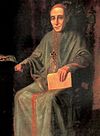
|
Francisco Xavier de Luna Pizarro (1780–1855) |
September 20, 1822 – September 22, 1822 | Independent | Interim officeholder, by resignation of San Martin (as President of the First Constituent Congress of Peru) | Interim President |
| style="background:Template:Independent (politician)/meta/color; color:black" |3 4 5 6 | 
|
Government Junta:
|
September 22, 1822 – February 27, 1823 | Independent | Elected by the Congress from among its members | Supreme Governing Board of Peru |
| style="background:Template:Independent (politician)/meta/color; color:black" |7 | 
|
José Bernardo de Tagle y Portocarrero, Marqués de Torre Tagle (1779–1825) |
February 27, 1823 – February 28, 1823 | Independent | Designated by the Congress after the Balconcillo mutiny | Interim President |
| style="background:Template:Independent (politician)/meta/color; color:black" |1 | 
|
José de la Riva Agüero y Sánchez Boquete (1783–1853) |
February 28, 1823 – June 23, 1823 | Independent | Ratified by the Congress after being imposed by the Balconcillo mutiny | Constitutional President |
| style="background:Template:Independent (politician)/meta/color; color:black" |8 | 
|
Francisco Valdivieso y Prada (1773–1828) |
June 23, 1823 – July 17, 1823 | Independent | Elected provisionally by the Congress to exercise power on areas not affected by the war, while Sucre assumed "military power" | Interim Head of the Government |
| style="background:Template:Independent (politician)/meta/color; color:black" |9 | 
|
Antonio José de Sucre y Alcalá (1795–1830) |
June 23, 1823 – July 17, 1823 | Independent | Elected provisionally by the Congress to exercise "military power" | Supreme Military Chief |
| style="background:Template:Independent (politician)/meta/color; color:black" |7 | 
|
José Bernardo de Tagle y Portocarrero, Marqués de Torre Tagle (1779–1825) |
July 17, 1823 – August 16, 1823 | Independent | Elected by the Congress, delegated by Sucre | Interim President |
| style="background:Template:Independent (politician)/meta/color; color:black" |7 | 
|
José Bernardo de Tagle y Portocarrero, Marqués de Torre Tagle (1779–1825) |
August 16, 1823 – February 10, 1824 | Independent | Ratified by the Congress as President (according to the new Constitution) | Constitutional President |
| style="background:Template:Independent (politician)/meta/color; color:black" |10 | 
|
Simón José Antonio de la Santísima Trinidad Bolívar y Palacios (1783–1830) |
February 10, 1824 – January 28, 1827 | Independent | Granted the supreme military and political authority by the Constitutional Congress | Liberator |
| style="background:Template:Independent (politician)/meta/color; color:black" |11 | 
|
Government Junta:
Andrés de Santa Cruz y Calaumana |
January 28, 1827 – June 9, 1827 | Independent | Elected by the Congress after the revolt that ended the Bolivarian regime | President of the Government Junta |
| style="background:Template:Independent (politician)/meta/color; color:black" |12 | 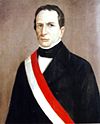
|
Manuel Salazar y Baquíjano (1777–1850) |
June 9, 1827 – August 22, 1827 | Independent | Vice President in charge of government (due to the arrival of La Mar from Guayaquil) | Interim President |
| style="background:Template:Independent (politician)/meta/color; color:black" |3 | 
|
José de la Mar Cortázar (1778–1830) |
9 June 1827 (22 August 1827) – 7 June 1829 (20 May 1828) | Independent | Elected by the Congress | Constitutional President |
| style="background:Template:Independent (politician)/meta/color; color:black" |13 | 
|
Manuel Salazar y Baquíjano (1777–1850) |
May 20, 1828 – June 6, 1829 | Independent | Vice President in charge of government (due to the absence of La Mar during the Gran Colombia–Peru War) | Interim President |
| style="background:Template:Military Rule/meta/color; color:black" |14 | 
|
Antonio Gutiérrez de la Fuente (1796–1878) |
June 6, 1829 – September 1, 1829 | Military | Coup d'état (in charge until the Congress elected the provisional president) | Commander-in-chief |
| style="background:Template:Independent (politician)/meta/color; color:black" |15 | 
|
Agustín Gamarra Messia (1785–1841) |
September 1, 1829 – December 19, 1829 | Independent | Elected by the Congress | Provisional President |
| style="background:Template:Military Rule/meta/color; color:black" |14 | 
|
Antonio Gutiérrez de la Fuente (1796–1878) |
September 21, 1829 – November 25, 1829 | Military | Provisional Vice President in charge of the government (due to trip of Gamarra on the occasion of the peace settlement with Gran Colombia) | Commander-in-chief |
| style="background:Template:Independent (politician)/meta/color; color:black" |16 | 
|
Agustín Gamarra Messia (1785–1841) |
December 19, 1829 – December 20, 1833 | Independent | Direct elections | Constitutional President |
| style="background:Template:Independent (politician)/meta/color; color:black" |17 | 
|
Francisco Xavier de Luna Pizarro (1780–1855) |
December 20, 1833 – December 21, 1833 | Independent | President of the National Convention (Constituent Congress) (in charge until the provisional president elected by the Congress took office) | Interim President |
| style="background:Template:Independent (politician)/meta/color; color:black" |18 | 
|
Luis José de Orbegoso y Moncada (1795–1847) |
December 21, 1833 – August 11, 1836 | Independent | Elected by the National Convention (Congress) | Provisional President |
Peru-Bolivian Confederation (1836–1839)
In 1836, the south of the country declared itself independent by creating the Republic of South Peru, while the north of the country became the Republic of North Peru. The two states confederated with the Republic of Bolivia to form the Peru–Bolivian Confederation on October 28, 1836. Marshal Andrés de Santa Cruz served as the Supreme Protector of the Confederation. Simultaneously, the actual control of each Republic remained in the hands of their respective presidents. The Peru-Bolivian Confederation dissolved on August 25, 1839.
| No. | Supreme Protector (Birth–Death) |
Term of office | Political Party | Title | |
|---|---|---|---|---|---|
| style="background:Template:Independent (politician)/meta/color; color:black" |11 | 
|
Andrés de Santa Cruz y Calaumana (1792–1865) |
February 7, 1836 (October 28, 1836) – August 25, 1839 (February 20, 1839) | Independent | Supreme Protector of the Peru-Bolivian Confederation |
Republic of North Peru (1836–1839)
The Republic of North Peru existed from August 11, 1836 until August 25, 1839.
| No. | President (Birth–Death) |
Term of office | Political Party | Title | |
|---|---|---|---|---|---|
| style="background:Template:Independent (politician)/meta/color; color:black" |18 | 
|
Luis José de Orbegoso y Moncada (1795–1847) |
August 21, 1837 – July 30, 1838 | Independent | Constitutional President |
| style="background:Template:Independent (politician)/meta/color; color:black" |19 | 
|
José de la Riva Agüero y Sánchez Boquete (1783–1858) |
August 1, 1838 – January 24, 1839 | Independent | Constitutional President |
Republic of South Peru (1836–1839)
The Republic of South Peru existed from March 17, 1836 until August 25, 1839.
| No. | President (Birth–Death) |
Term of office | Political Party | Title | |
|---|---|---|---|---|---|
| style="background:Template:Independent (politician)/meta/color; color:black" |20 | 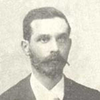
|
Ramón Herrera y Rodado (1799–1882) |
September 17, 1837 – October 12, 1838 | Independent | Constitutional President |
| style="background:Template:Independent (politician)/meta/color; color:black" |21 | 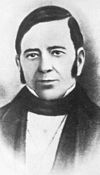
|
Juan Pío de Tristán y Moscoso (1773–1859) |
October 12, 1838 – February 23, 1839 | Independent | Constitutional President |
Republic of Peru (1839–)
The Republic of Peru was reestablished on August 25, 1839.
| No. | President (Birth–Death) |
Term of office | Political Party | Form of entry | Title | |
|---|---|---|---|---|---|---|
| rowspan="3" style="background:Template:Military Rule/meta/color; color:black" |22 | 
|
Agustín Gamarra Messia (1785–1841) |
August 25, 1838 – August 15, 1839 | Military | Proclaimed by open cabildo in Lima | President of the Republic |
| August 15, 1839 – July 10, 1840 | Appointed by the General Congress of Huancayo | Provisional President | ||||
| July 10, 1840 – November 18, 1841 (†) | Direct elections | Constitutional President | ||||
| style="background:Template:Independent (politician)/meta/color; color:black" |23 | 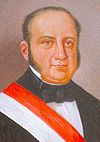
|
Manuel Menéndez Gorozabel (1793–1847) |
November 18, 1841 – August 16, 1842 | Independent | Constitutional succession (as Vice President) | Provisional President |
| style="background:Template:Military Rule/meta/color; color:black" |24 | 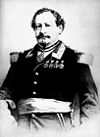
|
Juan Crisóstomo Torrico González (1808–1875) |
August 16, 1842 – August 20, 1842 | Military | Self-proclamation | Commander-in-chief |
| style="background:Template:Independent (politician)/meta/color; color:black" |25 | 
|
Juan Bautista de Lavalle y Zugasti (1782–1851) |
August 20, 1842 – October 20, 1842 | Independent | Took over the government as President of the Council of Ministers | Interim President |
| style="background:Template:Military Rule/meta/color; color:black" |26 | 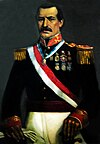
|
Juan Francisco de Vidal La Hoz (1800–1863) |
October 20, 1842 – March 15, 1843 | Military | Self-proclamation (assumed the power after defeating Torrico in the battle of Agua Santa) | President of the Republic |
| style="background:Template:Independent (politician)/meta/color; color:black" |27 | 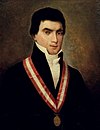
|
Justo Figuerola de Estrada (1771–1854) |
March 15, 1843 – March 19, 1843 | Independent | Provisional President | |
| style="background:Template:Military Rule/meta/color; color:black" |28 | 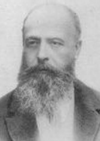
|
Eleuterio Aramburú (1774–1846) |
March 19, 1843 – March 21, 1843 | Military | Took over the government as commander of the garrison of Lima | Interim President |
| style="background:Template:Military Rule/meta/color; color:black" |29 | 
|
José Rufino Echenique (1808–1887) |
March 21, 1843 – March 27, 1843 | Military | Took over the government as Prefect of Lima | Interim President |
| style="background:Template:Military Rule/meta/color; color:black" |30 | 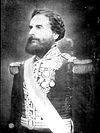
|
Juan Antonio Pezet (1809–1879) |
March 27, 1843 – April 7, 1843 | Military | Assumed the power on behalf of Vivanco | Interim President |
| style="background:Template:Military Rule/meta/color; color:black" |31 | 
|
Manuel Ignacio de Vivanco Iturralde (1806–1873) |
April 7, 1843 – June 17, 1844 | Military | Self-proclamation | Supreme Director of the Republic |
| style="background:Template:Military Rule/meta/color; color:black" |32 | 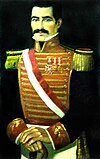
|
Domingo Nieto y Márquez (1803–1844) |
September 3, 1843 – February 17, 1844 (†) | Military | Self-proclamation (starting the constitutionalist revolution against Vivanco) | President of the Supreme Provisional Governing Junta |
| style="background:Template:Military Rule/meta/color; color:black" |33 | 
|
Ramón Castilla y Marquesado (1797–1867) |
February 17, 1844 – December 11, 1844 | Military | Replaced Nieto as President of the Junta | President of the Supreme Provisional Governing Junta |
| rowspan="2" style="background:Template:Independent (politician)/meta/color; color:black" |34 | 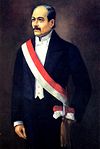
|
Domingo Elías Carbajo (1805–1867) |
November 30, 1843 – June 17, 1844 | Independent | Assumed the power on behalf of Vivanco (as Prefect of Lima) | Interim President |
| June 17, 1844 – August 10, 1844 | Self-proclamation in Lima (ignoring the authority of Vivanco) | Commander-in-chief | ||||
| style="background:Template:Independent (politician)/meta/color; color:black" |27 | 
|
Justo Figuerola de Estrada (1771–1854) |
August 10, 1844 – October 7, 1844 | Independent | Provisional President | |
| style="background:Template:Independent (politician)/meta/color; color:black" |23 | 
|
Manuel Menéndez Gorozabel (1793–1847) |
October 7, 1844 – April 20, 1845 | Independent | Transitional constitutional succession (as First Vice-President of the Council of State) | Provisional President |
| style="background:Template:Military Rule/meta/color; color:black" |33 | 
|
Ramón Castilla y Marquesado (1797–1867) |
April 20, 1845 – April 20, 1851 | Military | Direct elections | Constitutional President of the Republic (the first President of Peru to complete his full term of office) |
| style="background:Template:Military Rule/meta/color; color:black" |35 | 
|
José Rufino Echenique Benavente (1808–1887) |
April 20, 1851 – January 5, 1855 | Military | Direct elections | Constitutional President of the Republic |
| style="background:Template:Military Rule/meta/color; color:black" |33 | 
|
Ramón Castilla y Marquesado (1797–1867) |
February 1854 – January 5, 1855 | Military | Self-proclamation (in southern and central parts of the country) | Interim President |
| style="background:Template:Military Rule/meta/color; color:black" |36 | 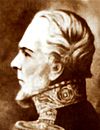
|
José Miguel Medina (1804-1884) |
July 17, 1854 – January 5, 1855 | Military | Assumed the power on behalf of Echenique (as President of the Council of State) | Head of the Executive Branch |
| style="background:Template:Military Rule/meta/color; color:black" |33 | 
|
Ramón Castilla y Marquesado (1797–1867) |
January 5, 1855 – October 24, 1857 | Military | Self-proclamation (assumed the power after defeating Echenique in the battle of La Palma) | Provisional President of the Republic |
| style="background:Template:Military Rule/meta/color; color:black" |37 | 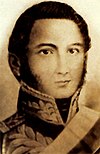
|
José Maria Raygada y Gallo (1795–1859) |
April 2, 1857 – July 28, 1858 | Military | Took over the government as President of the Council of Ministers | Commander-in-chief |
| style="background:Template:Military Rule/meta/color; color:black" |31 | 
|
Miguel de San Román y Meza (1802–1863) |
July 28, 1858 – October 24, 1858 | Military | Assumed the power on behalf of Castilla (as President of the Council of Ministers) | Commander-in-chief |
| style="background:Template:Military Rule/meta/color; color:black" |33 | 
|
Ramón Castilla y Marquesado (1797–1867) |
October 24, 1858 – October 24, 1862 | Military | Direct elections | Constitutional President of the Republic |
| style="background:Template:Independent (politician)/meta/color; color:black" |38 | 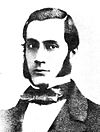
|
Juan Manuel del Mar (1805–1862) |
September 29, 1859 – March 21, 1860 | Independent | Assumed the power on behalf of Castilla (as Vice President) | Head of the Executive Branch |
| style="background:Template:Military Rule/meta/color; color:black" |31 | 
|
Miguel de San Román y Meza (1802–1863) |
October 24, 1862 – April 3, 1863 (†) | Military | Direct elections | Constitutional President of the Republic |
| style="background:Template:Military Rule/meta/color; color:black" |33 | 
|
Ramón Castilla y Marquesado (1797–1867) |
April 3, 1863 – April 9, 1863 | Military | Self-proclamation | Head of the Executive Branch |
| style="background:Template:Military Rule/meta/color; color:black" |39 | 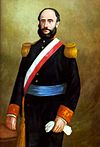
|
Pedro Diez Canseco Corbacho (1815–1893) |
April 9, 1863 – August 5, 1863 | Military | Provisional succession (as Second Vice President) | Commander-in-chief |
| style="background:Template:Military Rule/meta/color; color:black" |30 | 
|
Juan Antonio Pezet Rodríguez (1809–1879) |
August 5, 1863 – November 6, 1865 | Military | Constitutional succession (as First Vice President) | Constitutional President of the Republic |
| style="background:Template:Military Rule/meta/color; color:black" |39 | 
|
Pedro Diez Canseco Corbacho (1815–1893) |
November 6, 1865 – November 28, 1865 | Military | Provisional president | |
| rowspan="3" style="background:Template:Military Rule/meta/color; color:black" |40 | 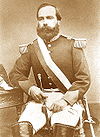
|
Mariano Ignacio Prado Ochoa (1825–1901) |
November 28, 1865 – February 15, 1867 | Military | Self-proclamation | Commander-in-chief of the Republic |
| February 15, 1867 – August 31, 1867 | Designated by Congress | Provisional President of the Republic | ||||
| August 31, 1867 – January 5, 1868 | Designated by Congress and direct elections | Constitutional President of the Republic | ||||
| style="background:Template:Military Rule/meta/color; color:black" |41 | 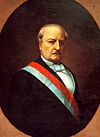
|
Luis La Puerta de Mendoza (1811–1896) |
October 12, 1867 – January 8, 1868 | Military | Assumed the power on behalf of Prado (as President of the Council of Ministers) | Head of the Executive Branch |
| style="background:Template:Military Rule/meta/color; color:black" |39 | 
|
Pedro Diez Canseco Corbacho (1815–1893) |
September 23, 1867 – January 7, 1868 | Military | Self-proclamation in Arequipa | Head of the Executive Branch |
| style="background:Template:Military Rule/meta/color; color:black" |42 | 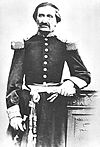
|
Antonio Gutiérrez de la Fuente (1796–1878) |
January 7, 1868 – January 8, 1868 | Military | Presidential designation (as President of the Council of Ministers) | Provisional president |
| style="background:Template:Military Rule/meta/color; color:black" |43 | 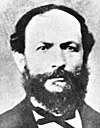
|
Francisco Diez Canseco (1821–1884) |
January 8, 1868 – January 22, 1868 | Military | Head of the Government | |
| style="background:Template:Military Rule/meta/color; color:black" |39 | 
|
Pedro Diez Canseco Corbacho (1815–1893) |
January 22, 1868 – August 2, 1868 | Military | Constitutional succession (recognized in Cabildo Abierto de Lima) | Provisional president |
| style="background:Template:Military Rule/meta/color; color:black" |44 | 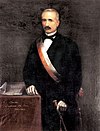
|
José Balta y Montero (1814–1872) |
August 2, 1868 – July 22, 1872 (July 26, 1872 [†]) | Military | Direct elections | Constitutional President of the Republic |
| style="background:Template:Military Rule/meta/color; color:black" |45 | 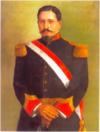
|
Tomás Gutiérrez (1817-1872) |
July 22, 1872 – July 26, 1872 (†) | Military | Coup d'état | Supreme Leader of the Republic |
| style="background:Template:Military Rule/meta/color; color:black" |43 | 
|
Francisco Diez Canseco (1821–1884) |
July 26, 1872 – July 27, 1872 | Military | Provisional succession (as Second Vice President of Balta) | Interim President |
| style="background:Template:Military Rule/meta/color; color:black" |46 | 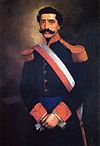
|
Mariano Herencia Zevallos (1820–1873) |
July 27, 1872 – August 2, 1872 | Military | Constitutional succession (as First Vice President of Balta) | Constitutional President of the Republic |
| style="background:Template:Civilista Party/meta/color; color:white" |47 | 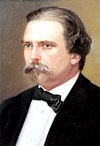
|
Manuel Pardo y Lavalle (1834–1878) |
August 2, 1872 – August 2, 1876 | Civilista Party | Direct elections | Constitutional President of the Republic |
| style="background:Template:Civilista Party/meta/color; color:white" |40 | 
|
Mariano Ignacio Prado Ochoa (1825–1901) |
August 2, 1876 – December 18, 1879 | Civilista Party | Direct elections | Constitutional President of the Republic |
| rowspan="2" style="background:Template:Civilista Party/meta/color; color:white" |41 | 
|
Luis La Puerta de Mendoza (1811–1896) |
May 16, 1879 – December 2, 1879 | Civilista Party | First Vice President (served on behalf of Prado) | Head of the Executive Branch |
| December 18, 1879 – December 23, 1879 | Constitutional succession | Transitional President of the Republic | ||||
| rowspan="2" style="background:Template:Independent (politician)/meta/color; color:black" |48 | 
|
Nicolás de Piérola Villena (1839–1913) |
December 23, 1879 – January 15, 1881 | Independent | Self-proclamation | Commander-in-chief |
| July 29, 1881 – November 28, 1881 | Appointed by the National Assembly of Ayacucho | Provisional President | ||||
| rowspan="2" style="background:Template:Independent (politician)/meta/color; color:black" |49 | 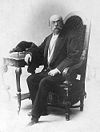
|
Francisco García Calderón Landa (1834–1905) |
March 12, 1881 – July 10, 1881 | Independent | Elected by open cabildo in Magdalena | Provisional President of the Republic |
| July 10, 1881 – September 28, 1881 (November 6, 1881) | Ratified by the Congress of Chorrillos | |||||
| style="background:Template:Civilista Party/meta/color; color:white" |50 | 
|
Lizardo Montero Flores (1832–1905) |
September 28, 1881 – October 28, 1883 | Civilista Party | Constitutional succession (oath before the Judicial Court of Cajamarca) | Provisional President of the Republic |
| rowspan="3" style="background:Template:Military Rule/meta/color; color:black" |51 | 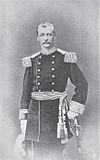
|
Miguel Iglesias Pino de Arce (1830–1909) |
August 31, 1882 – December 30, 1882 | Military | Self-proclamation in Cajamarca (Grito de Montán) | Commander-in-chief |
| December 30, 1882 – March 1, 1884 | Elected by the Assembly of the North (Cajamarca) | Regenerating President | ||||
| March 1, 1884 – December 3, 1885 | Ratified by the Constituent Assembly | Provisional President of the Republic | ||||
| style="background:Template:Military Rule/meta/color; color:black" |52 | 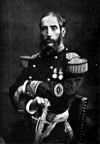
|
Andrés Avelino Cáceres Dorregaray (1836–1923) |
July 16, 1884 – August 3, 1885 | Military | Self-proclamation (central part of the country) | Self-proclaimed President |
| style="background:Template:Independent (politician)/meta/color; color:black" |53 | 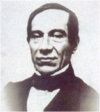
|
Antonio Arenas Merino (1808–1891) |
December 3, 1885 – June 3, 1886 | Independent | In charge of the Congress (as President of the Council of Ministers) | President of the Provisional Government Junta |
| style="background:Template:Constitutional Party (Peru)/meta/color; color:white" |52 | 
|
Andrés Avelino Cáceres Dorregaray (1836–1923) |
June 3, 1886 – August 10, 1890 | Constitutional Party | Direct elections | Constitutional President of the Republic |
| style="background:Template:Constitutional Party (Peru)/meta/color; color:white" |54 | 
|
Remigio Morales Bermúdez (1836–1894) |
August 10, 1890 – April 1, 1894 (†) | Constitutional Party | Direct elections | Constitutional President of the Republic |
| style="background:Template:Constitutional Party (Peru)/meta/color; color:white" |55 | 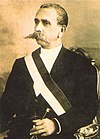
|
Justiniano Borgoño Castañeda (1836–1921) |
April 1, 1894 – August 10, 1894 | Constitutional Party | Constitutional succession (as Second Vice President) | Transitional President of the Republic |
| style="background:Template:Constitutional Party (Peru)/meta/color; color:white" |52 | 
|
Andrés Avelino Cáceres Dorregaray (1836–1923) |
August 10, 1894 – March 20, 1895 | Constitutional Party | Direct elections | Constitutional President of the Republic |
| style="background:Template:Independent (politician)/meta/color; color:black" |56 | 
|
Manuel Candamo Iriarte (1841–1904) |
March 20, 1895 – September 8, 1895 | Independent | Transitional designation | President of the Provisional Government Junta |
| style="background:Template:Democratic Party (Peru)/meta/color; color:white" |48 | 
|
Nicolás de Piérola Villena (1839–1913) |
September 8, 1895 – September 8, 1899 | Democratic Party | Direct elections | Constitutional President of the Republic |
| style="background:Template:Civilista Party/meta/color; color:white" |57 | 
|
Eduardo López de Romaña Alvizuri (1847–1912) |
September 8, 1899 – September 8, 1903 | Civilista Party | Direct elections | Constitutional President of the Republic |
| style="background:Template:Civilista Party/meta/color; color:white" |56 | 
|
Manuel Candamo Iriarte (1841–1904) |
September 8, 1903 – April 18, 1904 (May 7, 1904 [†]) | Civilista Party | Direct elections | Constitutional President of the Republic |
| rowspan="2" style="background:Template:Civilista Party/meta/color; color:white" |58 | 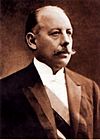
|
Serapio Calderón Lazo de la Vega (1843–1922) |
April 18, 1904 – May 7, 1904 | Civilista Party | Second Vice President (appointed due to the illness of Candamo) | Head of the Executive Branch |
| May 7, 1904 – September 24, 1904 | Constitutional succession (sworn in following the death Candamo) | Constitutional President of the Republic | ||||
| style="background:Template:Civilista Party/meta/color; color:white" |59 | 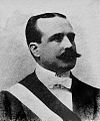
|
José Pardo y Barreda (1864–1947) |
September 24, 1904 – September 24, 1908 | Civilista Party | Direct elections | Constitutional President of the Republic |
| style="background:Template:Civilista Party/meta/color; color:white" |60 | 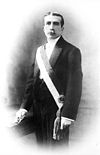
|
Augusto B. Leguía y Salcedo (1863–1932) |
September 24, 1908 – September 24, 1912 (1st term) |
Civilista Party | Direct elections | Constitutional President of the Republic |
| style="background:Template:Democratic Party (Peru)/meta/color; color:white" |61 | 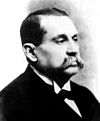
|
Guillermo Billinghurst Angulo (1851–1915) |
September 24, 1912 – February 4, 1914 | Democratic Party | Direct elections | Constitutional President of the Republic |
| rowspan="2" style="background:Template:Military Rule/meta/color; color:black" |62 | 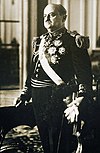
|
Óscar R. Benavides Larrea (1876–1945) |
February 4, 1914 – May 15, 1914 | Military | Coup d'état | President of the Government Junta |
| May 15, 1914 – August 18, 1915 | Ratified by Congress | Provisional President of the Republic | ||||
| style="background:Template:Civilista Party/meta/color; color:white" |59 | 
|
José Pardo y Barreda (1864–1947) |
August 18, 1915 – July 4, 1919 | Civilista Party | Direct elections | Constitutional President of the Republic |
| 60 | 
|
Augusto B. Leguía y Salcedo (1863–1932) |
July 4, 1919 – October 12, 1919 (2nd term) |
Democratic Reformist Party | Coup d'état after direct elections (already President-elect) | Provisional President of the Republic |
| October 12, 1919 – October 12, 1924 (2nd term cont.) |
Direct elections (before the coup d'etat) | Constitutional President of the Republic | ||||
| October 12, 1924 – October 12, 1929 (3rd term) |
Direct elections | Constitutional President of the Republic | ||||
| October 12, 1929 – August 25, 1930 (4th term) |
Direct elections | Constitutional President of the Republic | ||||
| style="background:Template:Military Rule/meta/color; color:black" |63 | 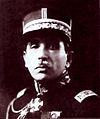
|
Manuel María Ponce Brousset (1874–1966) |
August 25, 1930 – August 27, 1930 | Military | Appointed President of the Military Junta constituted after the resignation of Leguía | President of the Military Junta |
| style="background:Template:Military Rule/meta/color; color:black" |64 | 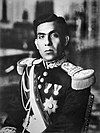
|
Luis Miguel Sánchez Cerro (1889–1933) |
August 27, 1930 – March 1, 1931 | Military | Coup d'état | President of the Government Junta |
| style="background:Template:Independent (politician)/meta/color; color:black" |65 | 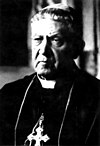
|
Mariano Holguín Maldonado (1860–1945) |
March 1, 1931 – March 1, 1931 | Independent | Presidential designation (while the Government Junta elected a President of the Republic) | President of the Assembly of Notables |
| style="background:Template:Military Rule/meta/color; color:black" |66 | 
|
Ricardo Leoncio Elías Arias (1874–1951) |
March 1, 1931 – March 5, 1931 | Military | Transitional designation by Board of Notables (as President of the Supreme Court) | President of the Provisional Board |
| style="background:Template:Military Rule/meta/color; color:black" |67 | 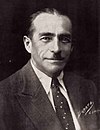
|
Gustavo A. Jiménez (1886–1933) |
March 5, 1931 – March 11, 1931 | Military | Coup d'état | President of the Transitory Government Board |
| style="background:Template:Independent (politician)/meta/color; color:black" |68 | 
|
David Samanez Ocampo y Sobrino (1866–1947) |
March 11, 1931 – December 8, 1931 | Independent | Transitional designation by Assembly of Notables | President of the Government Junta |
| 64 | 
|
Luis Miguel Sánchez Cerro (1889–1933) |
December 8, 1931 – April 30, 1933 (†) | Revolutionary Union | Direct elections | Constitutional President of the Republic |
| style="background:Template:Military Rule/meta/color; color:black" |69 | 
|
Oscar R. Benavides Larrea (1876–1945) |
April 30, 1933 – December 8, 1939 | Military | Designated by the Constituent Assembly | Constitutional President of the Republic |
| style="background:Template:Independent (politician)/meta/color; color:black" |70 | 
|
Manuel Prado y Ugarteche (1889–1967) |
December 8, 1939 – July 28, 1945 | Independent | Direct elections | Constitutional President of the Republic |
| 71 | 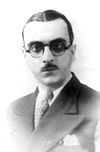
|
José Luis Bustamante y Rivero (1894–1989) |
July 28, 1945 – October 29, 1948 | National Democratic Front | Direct elections | Constitutional President of the Republic |
| style="background:Template:Military Rule/meta/color; color:black" |72 | 
|
Manuel A. Odría (1896–1974) |
October 29, 1948 – May 31, 1950 | Military | Coup d'état | |
| style="background:Template:Military Rule/meta/color; color:black" |73 | 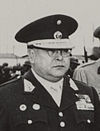
|
Zenón Noriega Agüero (1900–1957) |
May 31, 1950 – July 28, 1950 | Military | Provisional designation | Provisional President |
| 72 | 
|
Manuel A. Odría Amoretti (1896–1974) |
July 28, 1950 – July 28, 1956 | Odriíst National Union | Direct elections (only candidate) | Constitutional President of the Republic |
| style="background:Template:Pradist Democratic Movement/meta/color; color:white" |74 | 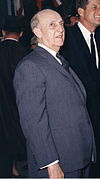
|
Manuel Prado y Ugarteche (1889–1967) |
July 28, 1956 – July 18, 1962 | Pradist Democratic Movement | Direct elections | Constitutional President of the Republic |
| style="background:Template:Military Rule/meta/color; color:black" |75 | 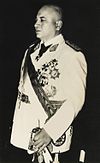
|
Ricardo Pérez Godoy (1905–1982) |
July 18, 1962 – March 3, 1963 | Military | Coup d'état | President of the Military Government Junta |
| style="background:Template:Military Rule/meta/color; color:black" |76 | 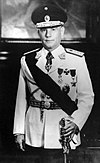
|
Nicolás Lindley López (1908–1995) |
March 3, 1963 – July 28, 1963 | Military | Coup d'état | President of the Military Government Junta |
| style="background:Template:Popular Action (Peru)/meta/color; color:white" |77 | 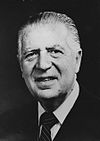
|
Fernando Belaúnde Terry (1912–2002) |
July 28, 1963 – October 3, 1968 | Popular Action | Direct elections | Constitutional President of the Republic |
| style="background:Template:Military Rule/meta/color; color:black" |78 | 
|
Juan Velasco Alvarado (1910–1977) |
October 3, 1968 – August 30, 1975 | Military | Coup d'état | President of the Revolutionary Government of the Armed Forces |
| style="background:Template:Military Rule/meta/color; color:black" |79 | 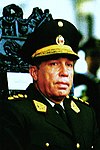
|
Francisco Morales Bermúdez Cerrutti (1921–) |
August 30, 1975 – July 28, 1980 | Military | Coup d'état | President of the Revolutionary Government of the Armed Forces |
| style="background:Template:Popular Action (Peru)/meta/color; color:white" |80 | 
|
Fernando Belaúnde Terry (1912–2002) |
July 28, 1980 – July 28, 1985 | Popular Action | Direct elections | Constitutional President of the Republic |
| style="background:Template:American Popular Revolutionary Alliance/meta/color; color:white" |81 | 
|
Alan García Pérez (1949–2019) |
July 28, 1985 – July 28, 1990 | American Popular Revolutionary Alliance | Direct elections | Constitutional President of the Republic |
| rowspan="4" style="background:Template:Cambio 90/meta/color; color:white" |82 | 
|
Alberto Fujimori Fujimori (1938–) |
July 28, 1990 – April 5, 1992 (1st term) |
Cambio 90 | Direct elections | Constitutional President of the Republic |
| April 5, 1992 – January 9, 1993 (1st term cont.) |
Self-coup. Dissolved the Congress | President of the Government of Emergency and National Reconstruction | ||||
| January 9, 1993 – July 28, 1995 (1st term cont.) |
Ratified by the Democratic Constituent Congress | Constitutional President of the Republic | ||||
| July 28, 1995 – July 28, 2000 (2nd term) |
Cambio 90 – Sí Cumple | Direct elections | Constitutional President of the Republic | |||
| style="background:Template:Sí Cumple/meta/color; color:white" |(82) | July 28, 2000 – November 21, 2000 (3rd term) |
Sí Cumple | Direct elections | Constitutional President of the Republic | ||
| style="background:Template:Popular Action (Peru)/meta/color; color:white" |83 | File:VPC May 2003.jpg | Valentín Paniagua Corazao (1936–2006) |
November 22, 2000 – July 28, 2001 | Popular Action | Constitutional succession (as President of the Congress) | Constitutional President of the Republic |
| style="background:Template:Possible Peru/meta/color; color:black" |84 | 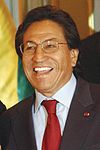
|
Alejandro Toledo Manrique (1946–) |
July 28, 2001 – July 28, 2006 | Possible Peru | Direct elections (2001) | Constitutional President of the Republic |
| style="background:Template:American Popular Revolutionary Alliance/meta/color; color:white" |81 | 
|
Alan García Pérez (1949–2019) |
July 28, 2006 – July 28, 2011 | American Popular Revolutionary Alliance | Direct elections (2006) | Constitutional President of the Republic |
| style="background:Template:Peruvian Nationalist Party/meta/color; color:white" |85 | 
|
Ollanta Humala Tasso (1962–) |
July 28, 2011 – July 28, 2016 | Peruvian Nationalist Party | Direct elections (2011) | Constitutional President of the Republic |
| style="background:Template:Peruvians for Change/meta/color; color:white" |86 | 
|
Pedro Pablo Kuczynski Godard (1938–) |
July 28, 2016 – March 21, 2018 | Peruvians for Change | Direct elections (2016) | Constitutional President of the Republic |
| style="background:Template:Peruvians for Change/meta/color; color:white" | 87 | 
|
Martín Vizcarra Cornejo (1963–) |
March 23, 2018 – present | Peruvians for Change | Constitutional succession (as First Vice President) | Constitutional President of the Republic |
Timeline

Living former presidents of Peru
All persons who have been non-interim presidents of Peru since 1985 were prosecuted in later years.
As of April 2019[update], there are five living former presidents of Peru. In order of office they are:
The most recent president to die was Alan Garcia (1985-1990, 2006-2011) on 17 April 2019, who committed suicide before being arrested.
Francisco Morales Bermudez
Bermudez was sentenced to life in prison by an Italian court in January 2017.[5]
Alberto Fujimori
Prior to his resignation in 2000, Alberto Fujimori escaped to his home country of Japan seeking political refuge, where he faxed his resignation to Peru. He unsuccessfully attempted to run for a parliamentary position in the Parliament of Japan, and ultimately returned to Latin America in 2006 to run for the 2006 presidential elections.
The refugee president's flight diverted to Chile, where he stayed for six days. Peruvian officials and the President of Peru during the time expressed discontent at Chilean officials for allowing the indicted former president into the continent without repercussion. Ultimately, Fujimori flew back to Peru for unstated reasons and was arrested.
Fujimori was convicted of corruption, bribery, human rights violations, crimes against humanities, murder, and other charges, for 25 years of prison until 2031. Fujimori served his sentence until 2017, where then Peruvian President Pedro Pablo Kuczynski issued a presidential pardon, clearing Fujimori of his conviction.
Following the resignation of Kuczynski, the pardon was declared illegitimate and Fujimori was arrested and returned to confinement. Presently, Fujimori still remains in custody, serving the rest of his 25-year sentence.
Alejandro Toledo
Following the end of his term in 2006, Toledo abruptly withdrew from Peruvian politics. Toledo and his spouse, Eliane Karp, both moved to California, in the United States, where they have resided since, to avoid persecution.
Toledo and the former First Lady were charged with multiple offenses of corruption and probing, and have been summoned to Peru for a trial. Toledo ignored this warning and proceeded to remain in the United States. Toledo claimed to have been a professor at Stanford University, but the university verified that Toledo was solely invited as a one-time guest speaker to the institution.
Many efforts have been made by former President Pedro Pablo Kuczynski and President Martin Vizcarra to extradite Toledo, but no responses have been heard from the United States government.
In March 2019, Toledo was temporarily arrested for public drunkenness in California, and was released later that night. Via a call in, Toledo denied that he was arrested. There is currently a $25,000 reward for the ex-president.
Ollanta Humala
Humala and former First Lady Nadine Heredia were abruptly arrested following the end of his term. Both of them were detained for 6 months for investigation on the means of corruption, but were later released.
There were no conclusions or evidence provided by the investigation. Humala continues to reside in Lima.
Pedro Pablo Kuczynski
Following his resignation in March 2018, Kuczynski quietly left the Government Palace and returned to his home in the district of San Isidro. Kuczynski remained out of the public eye for the following ten months, but was then summoned to the Department of Justice. All of Kuczynski's bank accounts were frozen and he was prohibited from leaving the country.
Kuczynski made few public appearances, but on the first anniversary of his resignation, Kuczynski made his first major public appearance on El Commercio. The former president mentioned his present financial ruins and the amounts of loans he was forced to make. Additionally, Kuczynski mentioned that he felt betrayed by Martin Vizcarra, the incumbent President of Peru who succeeded Kuczynski following his resignation.
On 10 April 2019, Kuczynski was arrested for primary corruption charges on the basis of an ongoing investigation into his connections with Odebrecht, money laundering, and bribery. At the end of his detention, Kuczynski was convicted to 3 years of prison until 2022.
Demographics of the presidents
In contemporary history, two presidents are known to not have been of direct Peruvian descent, being Alberto Fujimori (1990-2000) and Pedro Pablo Kuczynski (2016-2018). Fujimori is of Japanese descent and Kuczynski is of German and French descent.
Titles and styles
The President of the Republic of Peru is the Head of the Peruvian State, Head of the Peruvian Government and the Supreme Commander of the Peruvian Armed Forces.
The official style is:
His/Her Excellency [name of the president]
Common usages include:
El Presidente de la Republica / The President of the Republic
Line of succession
Names of incumbents as of 2018[update].
President of the Republic: Martín Alberto Vizcarra Cornejo
1- Vice President of the Republic: Mercedes Rosalba Aráoz Fernández
2- President of Congress: Daniel Enrique Salaverry Villa
3- First Vice President of Congress: Leyla Felícita Chihuán Ramos
4- Second Vice President of Congress: Segundo Leocadio Tapia Bernal
5- Third Vice President of Congress: Yeni Vilcatoma de la Cruz
See also
References
- ^ "Political Constitution of Peru, Article 112" (PDF).
- ^ Alemán, Eduardo; Tsebelis, George (2005). "The Origins of Presidential Conditional Agenda-Setting Power in Latin America". Latin American Research Review. 40 (2): 3–26. ISSN 0023-8791.
- ^ V., J. A. (1941). "La Tercera Asamblea General del Instituto Panamericano de Geografía e Historia". Boletín Bibliográfico de Antropología Americana (1937-1948). 5 (1/3): 1–4. ISSN 0186-064X.
- ^ Lynch, John (1983). "Bolivar and the Caudillos". The Hispanic American Historical Review. 63 (1): 3–35. doi:10.2307/2515357. ISSN 0018-2168.
- ^ "Italy gives Peru dictator life in prison for 1970s murders". Perú Reports. 2017-01-20. Retrieved 2019-04-03.








